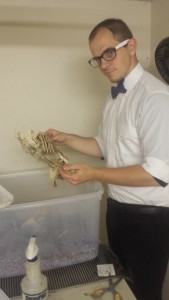My name is Stefan Hill and during my final semester as an undergraduate at Texas A&M University, I had the fortunate pleasure of interning at Texas A&M University’s Biodiversity Research and Teaching Collections (BRTC). It was the busiest semester I have had to date in my entire college career, but the experience I gained as an intern in these short few months have been one of the highlights of my academic study. I learned the ins and outs of how the specimens in the collection are selected, prepared, and managed for long term storage to promote the process of biodiversity conservation. One of these processes that I was directly involved with included the care of the dermestid beetle colonies used to clean animal skeletons. These beetles will eat the flesh off a skeleton and after a few days of chowing down, will leave a perfectly intact skeleton. It was pretty fascinating to observe this process first hand. I was able to witness all kinds of animals being placed into these colonies and, after only a matter of days, coming out looking completely unrecognizable. From watching deer, bear, and alligator heads to whole shark and squirrel bodies being consumed was a pretty cool experience overall.
The procedure of specimen preparation that I was involved in went in this sequence: Specimens would be skinned and tagged and placed in a freezer until there was room for them in the beetle colony. A metal tag with an ID number was then matched with the specimen number as a secondary means to keep track of each individual specimen. This is especially important because the beetles tend to move everything around and the skeleton becomes dismantled while the bugs are feeding. Once removed from the bugs, the skeletons are soaked in a 3:1 ratio of water to ammonia hydroxide to further clean the bones of oils and organic matter for 12 hours. If left to soak any longer, the chemical can actually do damage to the bones so it is crucial to remove them within this time frame. From the beginning I was warned that ammonia hydroxide is a very strong irritant and is incredibly volatile. Therefore, when using ammonia lots of ventilation as well as eye protection is needed, otherwise your throat, nose, and eyes will become horribly agitated by the fumes. Once removed from the chemical solution, the skeletons are air dried for 24-48 hours, boxed up, and placed into the freezer for another 7-10 days for a final fumigation step. After freezing, the specimen is assigned an identification number and installed into the collection for final storage.
The only real downside working with the beetles was the smell. The colonies were located in a separate shed several hundred feet behind the BRTC building for good reason. These things stank like no one’s business. The decaying carcasses combined with the beetle excrement and substrate creates a very strong, pungent, unique smell. It’s not necessarily a smell that makes you gag or get sick, but it’s still not all that pleasant to work with for long periods of time – mainly because it sticks to your clothes and is very noticeable to anyone else afterwards. I learned that lesson pretty early on after working with the beetles one afternoon and then biked back to campus on a particularly hot day for my next class. Sitting through a 50 minute lecture radiating a funky, mutated B.O. while my classmates conspicuously wrinkled their noses was enough ostracism for me to start bringing a change of clothes any time I worked with the beetles.

Pingback: Stefan Hill, Dermestid Care Level: Expert | Biodiversity Research and Teaching Collections | Department of Wildlife and Fisheries Sciences